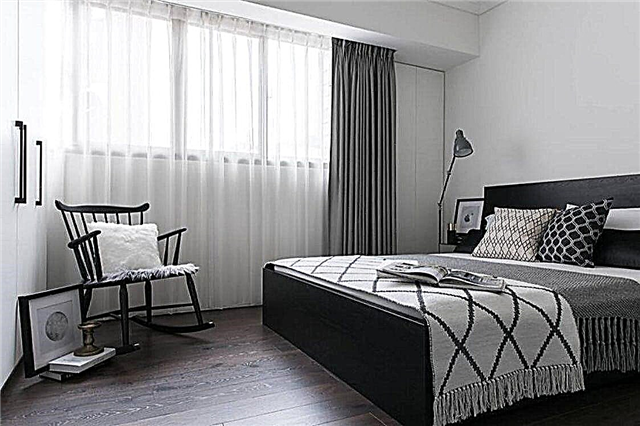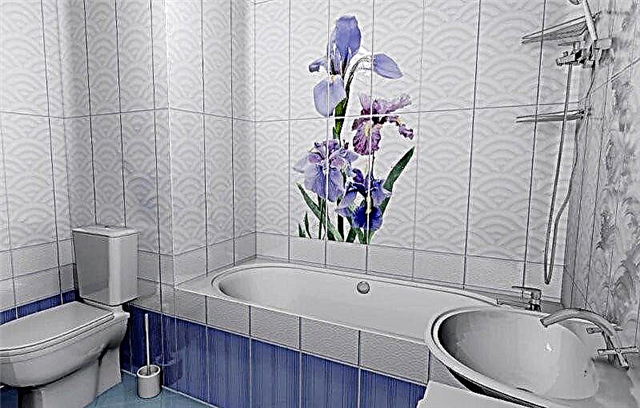When planning repairs in an apartment / house, special attention should be paid to the location of electrical accessories. It is advisable to outline a plan of the lighting scenario for each room, the layout of the switches, the connection of electrical appliances.
For example, outlets in the bedroom involve connecting a sconce (night lamp), iron, TV, charging a tablet, phone. Thinking everything in advance, you can ensure a comfortable, safe stay of the family in the room, excluding the presence of extension cords, additional wires, possible damage and short circuit. How many outlets do you need? How to correctly position them? We will answer this question in stages.
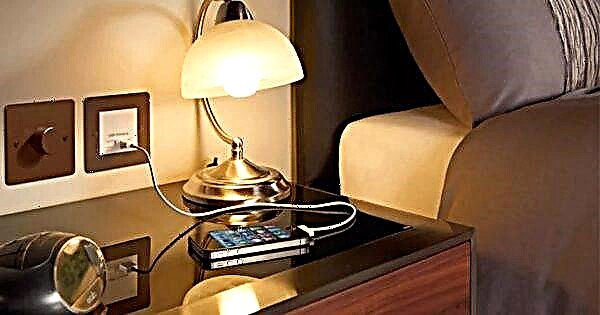
How many outlets are needed
The number of outlets in the bedroom depends on the number of people who will live here, their interests, the size of the room, the location of the furniture. If the room is for one person, then they can be a quarter less in comparison with a double room.
To have an idea of the minimum comfortable number and location of power points, you need to know where they should be installed.
So, most often a connector is needed:
- In the bedside zone, where they usually put nightstands with night lamps. It is very convenient for a family with a small child or for fans to read a magazine, newspaper or book. Moreover, the outlet needs to be installed near each bed.
- For a TV and related equipment. For this purpose, at least two outlets are installed.
- To connect the iron.
- Near the front door for a vacuum cleaner and other electrical appliances.
- Near the writing / dressing table. It is better to arrange several sockets for the electrical power of a table lamp, a computer and related equipment.
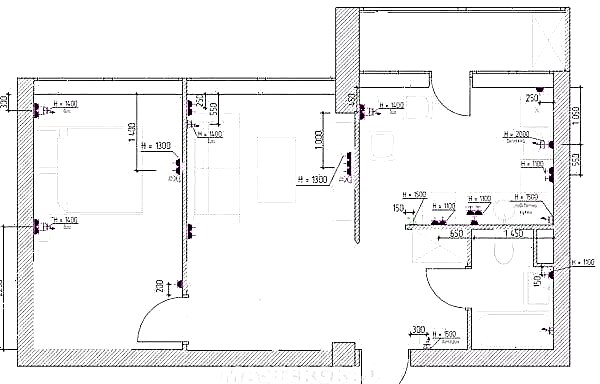
We summarize, we get 8 sources of electrical power. We emphasize: this is the minimum required amount, which should be for the improvement of a modern bedroom.
Socket at the bedside table
How many connectors for electrical appliances should be located near the bed? It all depends on the habits, lifestyle and needs of the owners of the room. Some people like to read literature in the light of a lamp or prefer to turn on a laptop / tablet to check their emails, sit on social networks, and play online games.
So, bedside outlets are needed to connect:
- small lamps - night lamps, sconces, bedside table lamps,
- charger of various gadgets: phones, laptops, tablets,
- additional technical devices: electronic alarm clock, salt lamp, receiver, heating pads, etc.
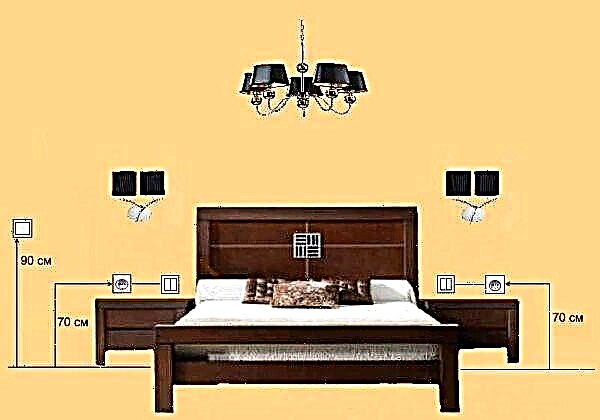
Outlets at the bed are located at arm's length from the bed, usually above the bedside table at a height of 10–20 cm.
Attention! Three outlets - this is the optimal amount for one berth. With a double bed, their number doubles.
Sockets for TV
Many people prefer to turn on the TV before going to bed to watch news, a movie, a program. Moreover, the TV is often used as a monitor that receives a signal from a digital or satellite TV tuner, DVD recorder or player, VCR (if any) and other video equipment. An additional source is needed for their power supply, but a “block” of several outlets is better.
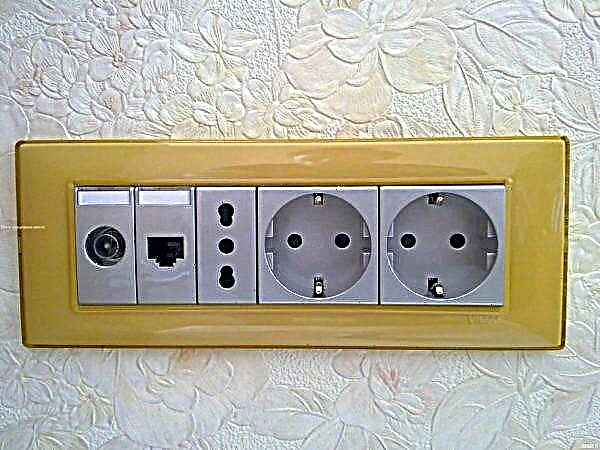
General purpose sockets
The location of wiring products near the front door, window sill is not always provided for by the designers, but their presence is necessary to connect:
- heaters: UV, Termoplaza, ceramic or oil heater,
- vacuum cleaner
- decorative fountain
- air conditioner
- humidifier etc.
If the bedroom is large, it is advisable to mount two blocks of sockets on the opposite walls of the room.
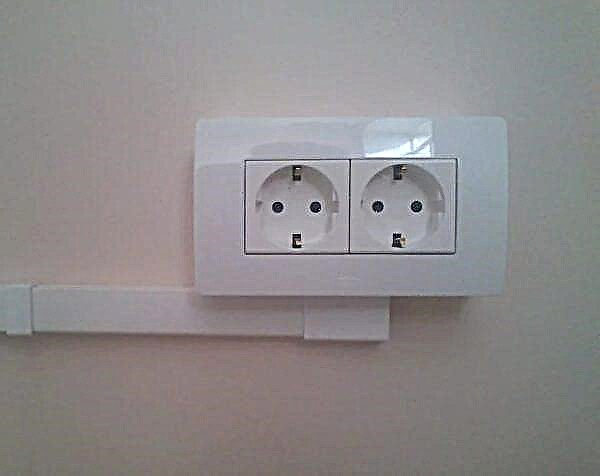
Iron Outlet
If there is no dressing room, laundry or linen room in the house / apartment, then you have to iron the linen in the bedroom. The iron belongs to powerful consumers of electricity, therefore, to connect it, regardless of the size of the sleeping quarters, a separate connector must be provided. It is installed at a distance of 10-15 cm from the ironing surface. Otherwise, it will not be so convenient to use an iron.
Socket at the dressing table
The room area near the dressing table is a favorite place of any woman. Usually there is a mirror with built-in or desktop lighting (and not one), a hairdryer, a curling iron and other items that help emphasize the female beauty.
To ensure the operation of electrical devices, a block of 3-4 outlets is located, rising 5-10 centimeters above the tabletop.
The height of the outlets in the bedroom
Two factors that take into account when choosing the height of the sockets, switches:
- convenience,
- harmonious combination with the interior of the room.
Advice! When calculating the height of the switches / sockets, consider the height of the finished floor.
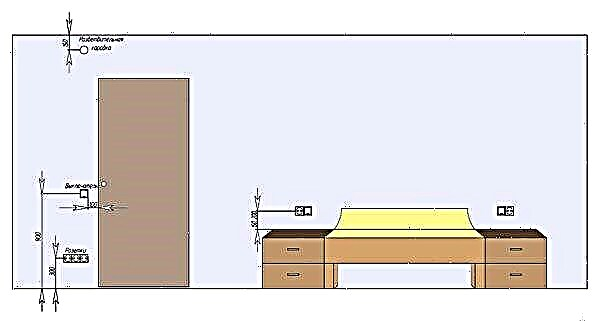
In the bedroom, all power points should be visible, easily accessible for regular use, and not installed according to the "European standard" - in the interval of 30 centimeters to the floor or according to the "Soviet" - in the interval of 90 centimeters above the floor surface.
Attention! It is strictly forbidden to place outlets less than 30 cm from the floor! The ingress of dust, debris, water during cleaning is fraught with the occurrence of a short circuit, failure of the wiring, even a fire.
Practical and standardized recommendations:
- place the connectors at a distance of 25 cm to the bedroom and at a distance of 60 cm to the floor or 10-15 centimeters to the surface of the countertops of the bedside table,
- separate the bedside connectors, placing them at a distance from each other and / or at different heights,
- to mount power supplies of electrical appliances on an open wall (without furniture) at a height of 50-100 centimeters,
- install sockets near the cabinet for mounting the backlight in it.
It is important that the sockets and switches are of high quality and harmoniously fit into the interior of the room. Therefore, it is recommended to buy only those wiring accessories that are made according to the European standard.
Required amount
The bedroom is the room where a person spends a third of his time. Therefore, it is important to ensure the optimal level of comfort in it. This characteristic largely depends on the location of the outlets. The number of these attributes may vary and depends on several key factors:
- The size of the bedroom. Small rooms can be equipped with two or three outlets for universal use. Often they are located in one of the functional areas (near the bed, at the door, etc.).
- Number of electrical appliances. This includes not only lamps or sconces, but also an iron, laptop and chargers for mobile phones. However, there is a possibility that all of these devices can be operated simultaneously.
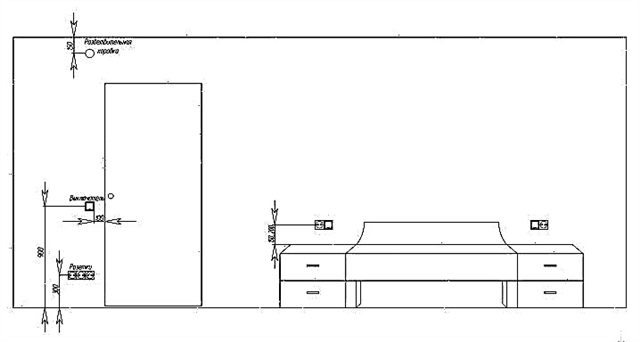
Therefore, before installing the sockets, it is advisable to draw up a diagram of their placement. This will allow you to place them in an optimal way, adapting to your needs.
For tv
Equipment of this type is less and less used in the bedroom. If, nevertheless, a TV installation is supposed to be in the design, experts recommend installing a whole block of 5-input sockets. Such designs are used for devices that are complemented by audio equipment, a tuner, or other auxiliary devices.
When you use only one TV, you can install one or at most two outlets. This approach is very common in conjunction with modern displays that can transmit a signal through wireless networks. For them, only the availability of a power source is important.
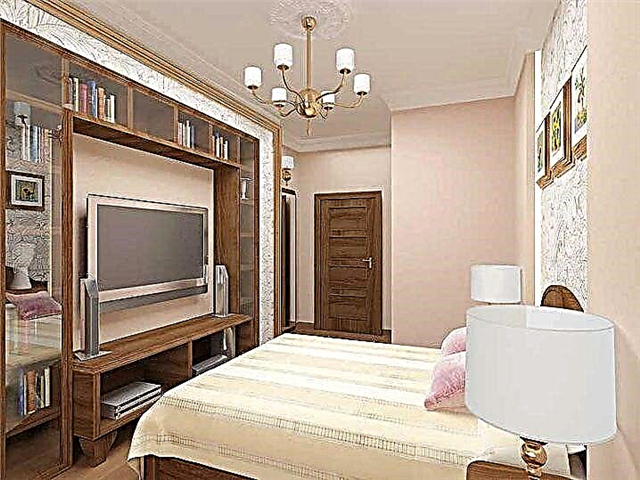
Under the iron
This household appliance is present today in almost every home. They often operate it in the bedroom, which requires the installation of a separate outlet for this. If the room is small, you can use the points located near the bed as a source. Please note that the iron is a powerful household appliance, therefore it is better to allocate a separate outlet for it. It should be designed for maximum loads.
The mounting height of this design varies only by your needs. The standard value is 100-120 cm from the floor. In this case, it is desirable to focus on the dimensions of the ironing board or other intended surface.
For other devices
This category includes a vacuum cleaner or heater, which are operated at a low frequency or during a certain period. Often place sockets for these devices near the door in an accessible place. Some experts recommend using several general-purpose sockets. It is advisable to place them at opposite ends of the bedroom in order to optimize their use. Please note that this approach is completely optional for small rooms, where one outlet can be used to solve various problems.
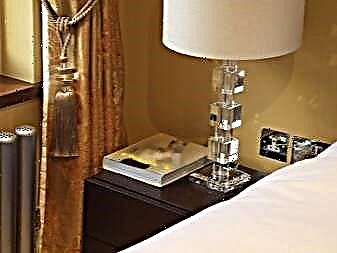
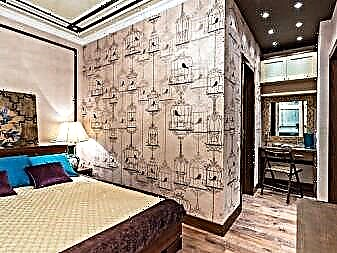
One more small nuance should be noted. If you plan to install an air conditioner in the bedroom, then you should first prepare an outlet for it. It should be placed close to the place of attachment of the structure. In this case, the product must withstand a large electrical load, since almost all air conditioners are very powerful.
Experts recommend using a separate line for such purposes, which is connected directly to the meter or power shield. If this is not done, then this can lead to failure of the entire network.
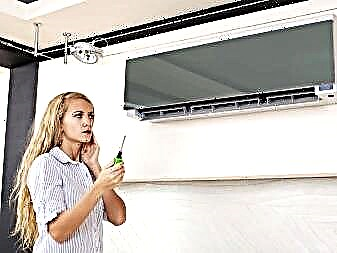
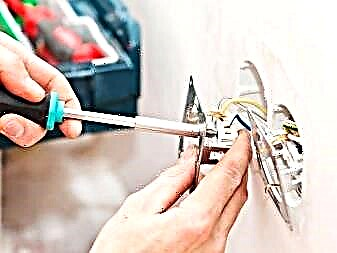
Near the pedestals
Bedside tables are often present in the classic design of modern bedrooms. They are used to arrange various household appliances, newspapers, magazines and other similar attributes on them. To optimize this space, it is advisable to install two sockets next to the bedside table. The distance from the furniture surface to this attribute should be at least 15 cm. It should be noted that if the bed is double, then there should be two such entry points. Their proper placement is on each side of the bed in order to optimize the access of lying people to them.
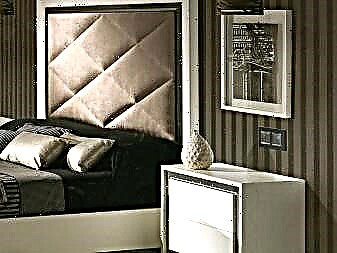
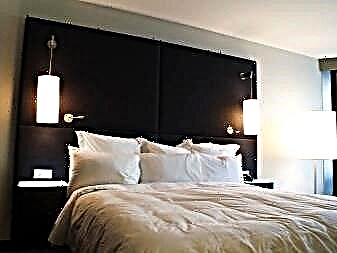
At the dressing table
This attribute of the interior is present only in large bedrooms. Often it is executed in the form of a small curbstone with a mirror. Here, owners can have several electrical appliances (hair dryer, epilator, etc.). Therefore, near the dressing table, you must definitely have a power outlet. If the number of tools is quite large, then it is advisable to increase this value to 2-4 pieces. The outlet is mounted directly above the surface of the table at a height of a few centimeters from it.
Please note that sometimes this point can be universal and can be used to start a vacuum cleaner, etc. It is only important that this outlet can withstand the load created by this technique.
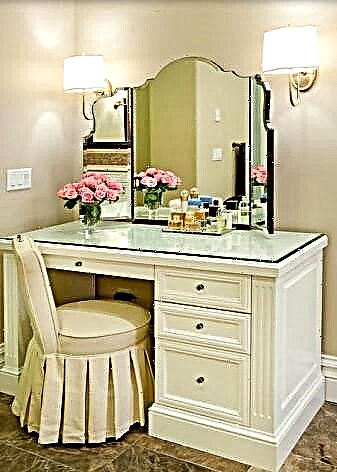
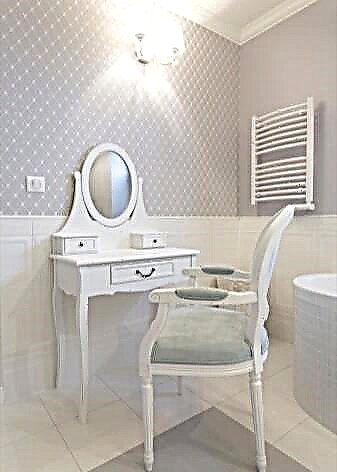
Height determination
Today there is no single standard indicating at what height the sockets should be mounted. For this, experts recommend that several key factors be followed:
- Security. When installing outlets, you should use only high-quality products that can withstand high loads. You need to do this, observing all the rules for laying cables and connecting them to the main electrical network.
- Practicality. All outlets should be located so that a person can quickly and effortlessly access them. In this case, the height does not play a role, as well as their number. Many points can be used to connect various sources. This must be taken into account in order to calculate how many outlets are needed for this room.
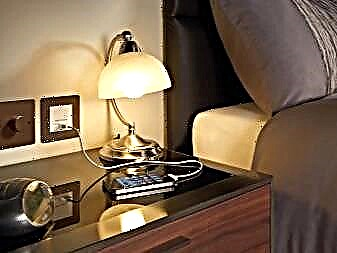
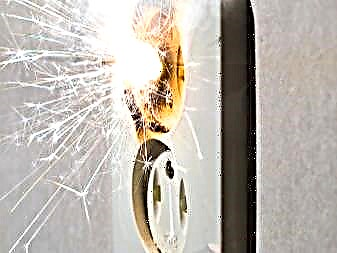
As for height, experts recommend placing the points a little higher above the surfaces where the devices will be used (25 cm above the bed, etc.). If these are general-purpose sockets, then it is advisable to mount them at a distance of 50-100 cm from the floor. Do not mount the devices very low to the floor, as there is a risk of moisture getting inside when wet cleaning. Also, this is not practical, as it forces a person to bend down to turn on a frequently used device.
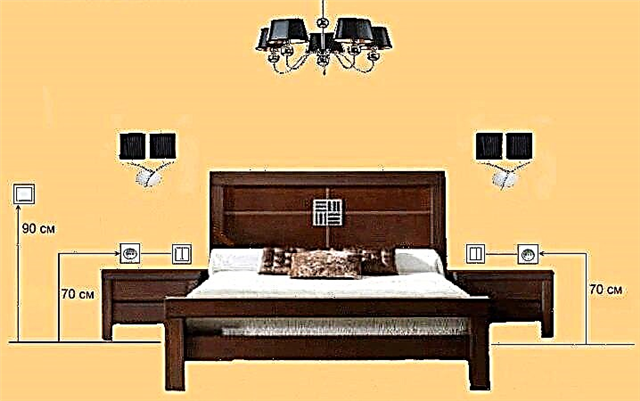
Design solutions
Classic models of sockets are available in white, which harmonizes with almost any type of interior. To beautifully fit products into the design, only built-in modifications should be used. It is also important to pay attention to the style of switches, which are very often mounted near sockets.
If the interior of the bedroom was created by the designer, retro designs that are characterized by the corresponding appearance can complement it. They can also be supplemented with appropriate wiring and switches.
The selection and installation of outlets is an important task that should only be solved with experienced specialists. This will not only speed up the installation, but also provide the bedroom with the optimal number of power supplies.
See how to properly position the outlet in the bedroom in the next video.
What is the right electrician
Technical and security issues of the electrical system in a home or electricians in an apartment are professional electricians generally called the most important evaluation criterion for this system. This is of course true, but comfort, practicality and universality of the arrangement of the electrical system are also very important.
To satisfy both requirements - functionality and safety - the designer must carefully design the entire system based on the requirements of standards and regulations, while at the same time taking into account the wishes of the customer. This is a very important step in the mechanisms for planning overhauls or building an apartment or house. Before designing, you should initially know how this or that space in your house will be arranged (rooms, bathroom, kitchen, and so on).
Planning for switches and sockets
It is estimated that each person uses approximately six different electrical appliances per day. And the number is constantly growing. New devices and gadgets appear, without which it is difficult to imagine life.
Devices fill our homes, and the number of sockets remains unchanged.
To avoid cosmetic repairs when installing / moving electrical wiring, you must always take the time to plan the location of sockets and switches in the apartment. For example, when ordering a project from an interior designer, the application must indicate the exact number of network connectors and circuit breakers, as well as their location. Since the interior designer may not know that you prefer to work on a laptop on the couch.
The approval of the project is the point to which all wishes are accepted and amendments are made to the project.
With independent planning of the interior, it is important to understand the purpose of the room and its design. The location of the furniture is also taken into account, since the outlet behind the wardrobe is a useless thing. And if you like to rearrange all the furniture in the room every six months? It turns out that the calculation of the number of circuit breakers and sockets is carried out only after the development of the design.
Laws and technical regulations
Construction standards that strictly regulate the number and location of network connectors and switches in the house are not prescribed at the legislative level. But there is a document called the “Code of Design and Construction Rules” or SP 31-110-2003, which spells out recommendations on where to place circuit breakers and power connectors.The first are located on the side of the door handle at a height of up to 1000 mm, and the second - in a convenient place, but at the same height. It should be guided only by common sense and own choice.
Rules for placing switches
The switch for the main lighting is usually placed near the doorway at a height of 750–900 mm. Height calculation should be based on the average height of all adults in the family. As a result, everyone should comfortably press the switch button without raising their hands.
Power points for lighting fixtures in the bathroom, restroom and pantry must be mounted in the hallway. For living rooms, a kitchen, as well as the corridor itself, the location inside the premises will be correct. Wiring devices for adjusting auxiliary or decorating lighting are mounted in a convenient place, but taking into account the design.
Features of the placement of outlets

The height of the outlets is the cause of many disputes. Do not believe the "European standard" - 15 cm from the floor, but consider only the number of devices. For greater convenience, consider each room in the house.
- The corridor.
For the corridor, it will be enough to have one outlet in the corner above the baseboard, at a height of 15-20 cm from the floor. Here you can connect an electric shoe dryer or charge the guest phone.
- Bathroom.
It will be enough 1-2 outlets. One is near the mirror for the hair dryer and electric shaver at a height of 100 cm. If you plan to install the washing machine in the bathroom, the outlet for it should be placed at a height of 50-60 cm from the floor.
In the bathroom, it is better to use sockets with special protection against moisture.
- Living room.
For a TV or home theater, two outlets are enough: one for the receiver, the other for a subwoofer or an external TV tuner. Choose the height of placement based on the location of the TV: the cord should not hang down or stretch to the outlet, but completely hide behind the screen. At a height of 15-30 cm from the floor, place two pieces on each wall: for a floor lamp, humidifier, chargers, game consoles, and a vacuum cleaner.
- Kitchen.
The kitchen uses the largest amount of equipment: range hood, dishwasher and washing machines, electric stove, small appliances (mixer, blender, microwave, food processor, etc.), refrigerator, freezer. The list is growing every year.
For the refrigerator, the outlet is placed on the wall behind it at a height of 60-80 cm. For the hood, mount the outlet at a height of 180-200 cm from the floor. For dishwasher and washing machine, electric stoves - placed at a height of 20-30 cm from the floor - holes for them are cut in size in the back wall of the kitchen furniture. Above the level of the working surface (5-10 cm), place three sockets for small equipment. The TV in the kitchen is mounted on a wall bracket. The optimal height of the outlet is 180-200 cm.
- Bedroom.
There will be enough for two outlets on both sides of the bed: for bedside lamps and additional appliances. Near the dressing table, one thing will be enough at a height of 60-70 cm from the floor for a hairdryer.
- Study.
A computer will require a minimum of five outlets (system unit, monitor, speaker subwoofer, and one for a desk lamp, printer, or scanner). Near the shelves with books usually equip a place for reading: a floor lamp and a comfortable chair - this is another outlet. Two additional sockets are mounted on a free wall. All sockets are placed at a height of 15-30 cm from the floor.
- Children’s.
A children's room usually combines a bedroom and a play area. Near the bed you will need a night light socket and two sockets for additional appliances. For this room, choose sockets with special protection "from children", or rather - from children's curiosity. The plug holes are protected by special valves and it takes effort to plug the appliance into such a socket.
The outlet for the air conditioner is located at a distance of 30cm from the ceiling.
The location of the outlets in the bedroom: diagram
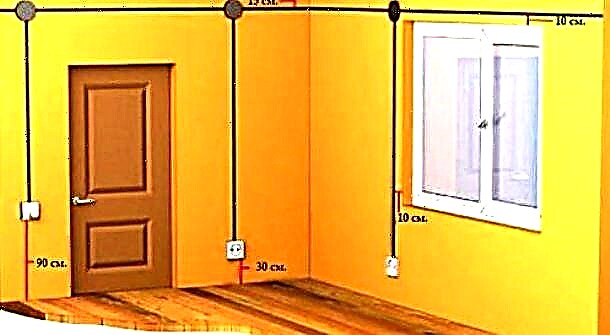
How to place sockets and switches you decide only taking into account comfort and safety. Now there are no strict standards for the placement of switches and sockets, and for their number in each particular room.
Count the number of devices that you will use in each room constantly and add two more sockets for additional devices. The main requirements are put forward only to the masters who will carry out work on installing the electrical network in the house: they must be specialists.
Sockets for TV on the wall
Many people prefer to turn on the TV before going to bed to watch news, a movie, a program. Moreover, the TV is often used as a monitor that receives a signal from a digital or satellite TV tuner, DVD recorder or player, VCR (if any) and other video equipment. An additional source is needed for their power supply, but a “block” of several outlets is better.
How many separate groups should be
Separate groups are called sockets that are powered from their line and also have a separate machine. By standard, there are usually no more than two or three, although in reality, in a good way, there should be much more.
- Separate line for the working area. This line is intended for such devices as: kettle, microwave, mixers and many others. Sockets for countertops in the kitchen are located in the necessary places where kitchen appliances are most often used. For convenience, there should be at least two sockets with two to three sockets.
- Separate line for washing machine, refrigerator, dishwasher and electric stove.
You can combine power devices, for example, a dishwasher and a washing machine located on one group, which has a differential machine (power 20 Am). It is worth paying attention to that the total power of both devices should not exceed 4 kV.
It is highly recommended not to run two or three devices at the same time at the same time.
You can’t do such a maneuver with a refrigerator - it should be on a separate line. So we recommend not only us, but also says the instructions of manufacturers of household appliances.
- If you do not want to shorten the operational period of your device, then listen to the following recommendations:
First of all, this is the safety of your apartment and the safety of expensive equipment. Installing the refrigerator on a shared line with another appliance may result in improper distribution of the voltage in the network, resulting in heavy loads.
Each individual group should be equipped with a differential machine, or a machine protected by an RCD.
- Obviously, you can save a lot on the fact that the electrical work is even cheaper, for example:
Such a power grid will work, and may even never bother you, with the exception of strong voltage and the operation of automatic machines. But no one will give you guarantees that everything will work properly and that there will be no consequences.
Socket for a stove in the kitchen - installation standards
Installation of a new stove, especially an electric one, is necessarily accompanied by a connection procedure. Sometimes an electrician is invited for this type of work, but more often they cope on their own.
In order for the new equipment to last for a long time, and in the process of operation there are no problems, you should carefully consider the technical standards for its installation.
Particular attention should be paid to the selection and installation of the appropriate power connector. The opinion that for an electric stove it is enough to install the most ordinary outlet, is wrong. It will not be able to withstand high loads and, at best, will simply melt. For powerful electrical appliances, special sockets are used that can withstand 7 kW or more.
Power sockets on the market differ in color, workmanship, shape, installation method and withstand load. When buying this device, you must immediately buy the corresponding plug. Often manufacturers of electric stoves complete their equipment with a power plug and socket - all that remains is to install them correctly.
According to the material of manufacture, power sockets are made of carbolite and high-quality plastic. The first option is black, they are usually cheaper. Plastic are presented mainly in white. They cost more, are of high quality and increased level of durability.
- By the method of installation, power sockets are distinguished:
If it is to be installed behind a plate that is firmly against the wall, it is better to choose models of a hidden installation, the working mechanism of which is hidden in the wall. Among high-power outlets, you can find both options with a grounding contact, and without grounding. For an electric stove, you should buy a ground outlet. Food in the house can be single-phase, three-phase and rarely two-phase.
Based on this feature, you need to choose a socket that has the necessary contacts and lay the appropriate power cable. In order to correctly choose the power connector suitable for the electrical network entering the house, you need to find out in advance from the electricians who are servicing the site, the type of network and the presence of grounding. Their answers should be unambiguous and clear. Only after this can you independently begin to purchase and further install a power outlet.
Correct location of sockets in the kitchen for built-in appliances
- There are several rules that you must follow when drawing up the layout of outlets:
Connecting the hood from the outlet
The most common option is to connect through a power outlet for the hood. As a matter of fact, the hood itself is also designed for this option, because all of them have a plug.
Connection hood without outlet
Quite often you can find the option of connecting the hood without an outlet. The wires brought to the outlet simply connect rigidly to the exhaust wires.
Connection of a hood from a group machine
The last possible connection option is the allocation of a separate machine in the group panel for connecting the hood. This type of connection is recommended for powerful consumers, to which the hood is very difficult to attribute. Nevertheless, he has a right to exist.
- The essence of this method comes down to the fact that, as in the video, you install an additional automatic machine in the apartment panel. From it a separate line feed the hood.
- And in this case, it is better to lead the wire from the machine directly to the hood terminal block, avoiding additional connections. And the exhaust wire is easy to dismantle.
In this case, you have to open the hood housing. This may violate the warranty. Although the dismantling of only the exhaust hoods, as we considered in the previous version, also leads to a violation of operating conditions from the removal of equipment from the guarantee.
Despite the fact that the power of a conventional hood rarely exceeds 400W, you will need a copper wire with a cross section of 1.5 mm2. After all, according to the table. 7.1.1 PUE is the minimum permissible wire cross-section that is allowed in residential premises.
Socket for air conditioning - location and scheme
The outlet for the air conditioner must have certain characteristics.
- Before installation, it is necessary to check its parameters:
The connection of the network and the outlet must be through an automatic switch. When choosing it, the inrush current is taken into account. This value exceeds the nominal value. To calculate the characteristics of the machine, the power of the cooling device is divided by the mains voltage and increased by 30%.
Before connecting to the network, the external and internal unit of the air conditioner is connected.
- Work is carried out in the following order:
- If a separate line is laid, the following recommendations must be observed to power the cooling unit during installation:
In order for the air conditioner to work qualitatively for a long time when choosing a power outlet, one should take into account not only its quality characteristics. It must correspond to the size of the load used and have a reliable connection to the cooling system.
1. In bedside tables
The location of sockets and switches in the bed area directly depends on the type of lighting and the size of the furniture. If you decided to hang a sconce at the head, then the sockets can be placed above the bedside table in the same frame with the switch. Note that the height of the lower edge of the switch from the surface of the cabinet must be not less than 10 cm
If the bed is double, then such sockets must be provided on both sides.
If you chose table lamps for lighting, then sockets can be placed between the bed and the nightstands, immediately behind the nightstand or under the nightstand, if it is on high legs. Making an extra light switch next to the bed is a great idea, because sometimes it's too lazy to get out of a warm bed.
If it seems to you that you will manage with only two outlets, remember how many different devices are usually used in the bedroom: a phone, a laptop, an air humidifier, an electronic alarm clock and even a photo frame. Better safe than sorry.


